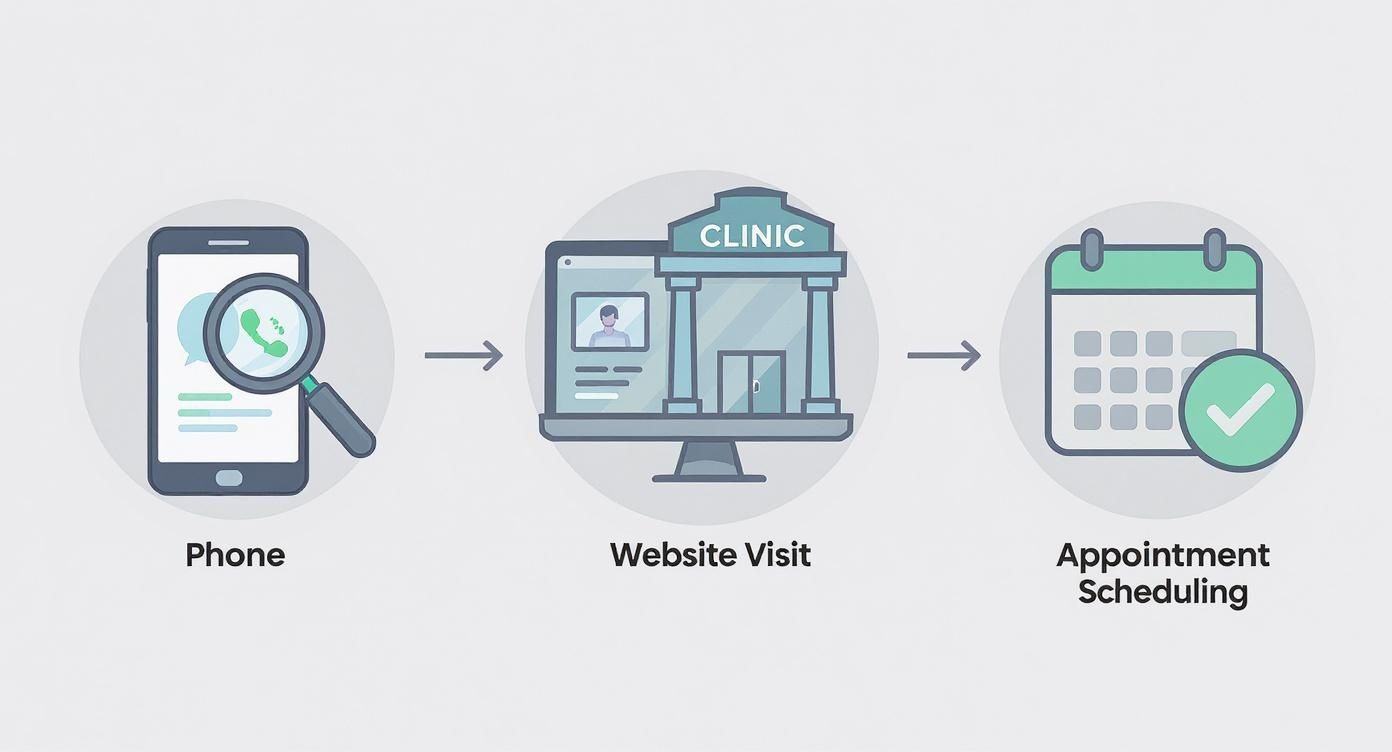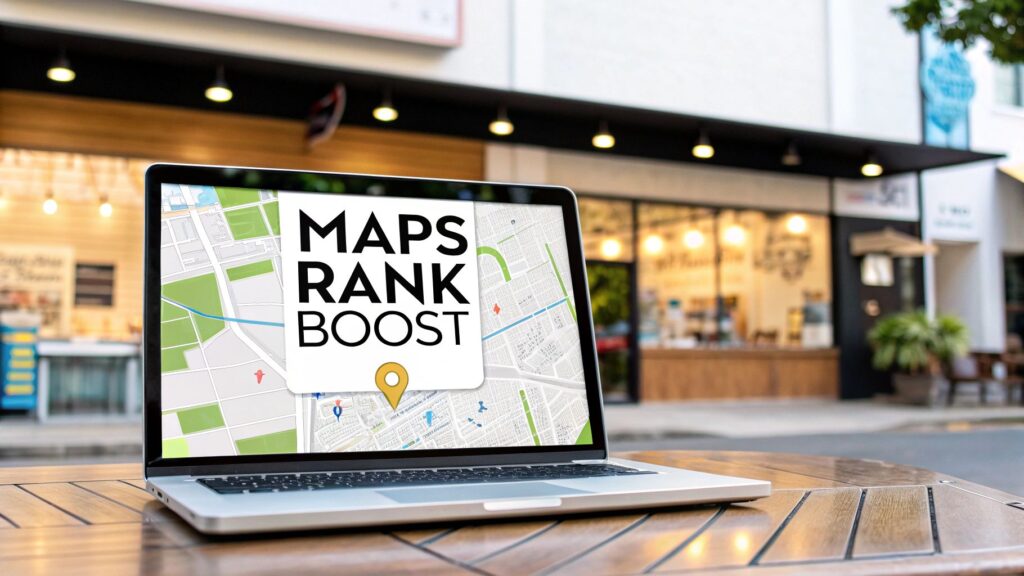Let's be clear—relying only on word-of-mouth referrals isn't enough to grow a podiatry practice anymore. Your next patient is probably searching "podiatrist for heel pain near me" on their phone right now. This is why SEO for podiatrists is the most important tool for growing your clinic. It’s how you get found by people who need your help.
Why Google is Your New Front Door
Think about it. When you need a local service, you go straight to Google. Your potential patients do the same thing for their foot and ankle pain.
The modern patient journey begins with a search engine. If your practice isn't on the first page of Google, you're practically invisible. SEO is simply the process of making sure your clinic is the first and best answer they find.
In Short: SEO connects your clinic with local patients who are actively searching for a podiatrist.
The Shift from Referrals to Search
Doctor-to-doctor referrals still happen, but patients now have the power. They want information and convenient options, fast. SEO puts local, well-reviewed podiatry practices at their fingertips. This isn't just about getting found; it's about getting chosen.
A strong online presence builds trust before a patient even calls you. It lets you:
- Show your expertise with helpful blog posts on conditions like plantar fasciitis or bunions.
- Build social proof by displaying positive Google reviews from happy patients.
- Make booking easy with clear contact info and online appointment forms.
A digital-first approach is essential. Data shows that most online health searches are for local medical care. This trend makes local SEO a must-do for every podiatrist.
What This Means for Your Practice
Investing in SEO for podiatrists means you stop waiting for the phone to ring. Instead, you put your practice directly in front of motivated people ready to book an appointment. It's the most direct path to growing your patient list.
Getting found on Google is just one piece of the puzzle. It's also smart to explore other proven strategies to increase patient volume for a well-rounded marketing plan. The goal is simple: when someone in your town needs foot care, your name should be the first one they see.
Winning Local Search in Your Area
When a patient needs a podiatrist, they want someone nearby. That's why local search is your most powerful tool for getting new patients. Mastering local SEO is like putting up a giant sign for your clinic that only people actively looking for foot care in your area can see.
The most important part of this strategy is your Google Business Profile (GBP). This free listing is often a patient's first impression of your practice.
Your Google Business Profile Is Your Digital Storefront
Your GBP is more than just a map pin. It's an interactive profile that can attract new patients or send them to a competitor. Getting it right is non-negotiable.
Every detail must be accurate and complete. A neglected profile suggests a neglected practice.
Here’s how a patient typically finds you:

This simple journey shows how critical that first online impression is. First, make sure your Google Business Profile is claimed and verified. Then, you can start optimizing it.
Your Google Business Profile Optimization Checklist
Follow these steps to make your GBP attract local patients.
| Optimization Task | Why It Matters for Patients | Actionable Tip |
|---|---|---|
| Claim & Verify | Ensures you own the listing and can manage the information. | Go to google.com/business and follow the verification steps. |
| Perfect NAP | Provides accurate, one-click directions and contact info. | Make sure your Name, Address, and Phone number match your website exactly. |
| Choose Categories | Helps them find you for specific needs like "diabetic foot care." | Set your primary category to "Podiatrist." Add secondary categories for other services. |
| Add Photos/Videos | Builds trust by showing your clean office and friendly staff. | Upload high-quality photos of your clinic, team, and equipment. A welcome video is even better. |
| Enable Messaging | Gives them an easy way to ask a quick question without calling. | Turn on messaging in your GBP dashboard and respond quickly. |
| Use Google Posts | Keeps them updated on clinic news, offers, or services. | Share a new post at least once a week. It can be a blog link or holiday hours. |
| Build Reviews | Social proof is crucial. Positive reviews show you're a trusted provider. | Actively ask happy patients for reviews. Send a direct link via email or text to make it easy. |
In Short: Keep your Google Business Profile updated regularly to stay at the top of local search results.
The Power of NAP Consistency
One of the most basic parts of local SEO is your NAP—Name, Address, and Phone number. Google uses this info to verify your practice is a legitimate local business.
Even small inconsistencies can cause confusion and hurt your rankings. If your GBP says "Main Street Foot Clinic" and Yelp has "Main St. Foot Clinic," it's a problem.
- Name: Use your official practice name. Don't add keywords like "Best Podiatrist."
- Address: Make sure the street name, suite number, and zip code are identical everywhere.
- Phone Number: Use a single, local phone number across all platforms.
This consistency builds trust with search engines, which helps you rank higher.
Reviews Are Your Digital Word-of-Mouth
Reviews are the lifeblood of a local practice. A steady stream of recent, positive reviews is a powerful signal to both Google and patients that your clinic provides excellent care.
A 4.8-star rating with 150 reviews will almost always outrank a perfect 5.0-star rating with only 10 reviews. Google values both quality and quantity.
Have a system for asking happy patients for reviews. Make it easy by sending a direct link to your GBP review page via email or text. Also, respond to all reviews—good and bad. It shows you care about patient feedback.
Expanding Beyond Google with Local Citations
While Google is king, other directories matter. Your practice's NAP info should be consistent across other relevant sites, known as local citations.
Think of sites like:
- Yelp
- Healthgrades
- Vitals
- WebMD
- Your local chamber of commerce
Each consistent citation is another vote of confidence for your practice. Building these citations is a core part of a winning SEO for podiatrists strategy. To learn more, our guide on how local maps SEO works explains why these listings are so critical.
What Are Patients Actually Searching For?
Good SEO for a podiatry practice is about understanding your patients. Forget the jargon for a minute. Imagine someone with sharp heel pain. What would they type into Google?
It probably won’t be “podiatric services.”
They’re more likely to search “why does my heel hurt in the morning?” or “foot doctor for runners near me.” This is how real people talk. Finding these phrases is your secret weapon. Good keyword research is more about empathy than data.
Think Like a Patient, Not a Doctor
You know the clinical term for every condition. Your patients don't. They use everyday language to describe their pain. Your job is to bridge that gap.
Brainstorm the common problems you see each week—plantar fasciitis, bunions, ingrown toenails. Then, think about how a patient would describe them.
-
You say: Plantar Fasciitis
-
A patient searches: “sharp pain in heel when I wake up”
-
You say: Onychocryptosis
-
A patient searches: “sore big toe corner” or “how to fix ingrown toenail”
This shift in perspective is the foundation of a keyword strategy that attracts the right people.
Use Google as Your Research Assistant
You don’t need expensive software to find great keywords. Google itself is a powerful and free research tool.
Start typing a patient-focused phrase like "bunion treatment" into the search bar. The Google Autocomplete suggestions show you what people are actively searching for. It’s a goldmine.
Next, scroll down to the "People Also Ask" box. This is Google giving you a list of your potential patients' exact questions.
- What do podiatrists do on the first visit?
- Can a podiatrist remove a bunion?
- How much does it cost to see a podiatrist for an ingrown toenail?
Each question is a great idea for a blog post or a section on a service page. Answering these questions directly makes you a helpful, trusted expert.
High-Intent Keywords Drive Appointments
Not all keywords are equal. Some show curiosity, while others signal someone is ready to book an appointment.
Broad keywords like "foot pain" are competitive and attract people who are just starting their research. They have low commercial intent.
Longer, more specific phrases—long-tail keywords—mean the searcher is ready to act. These high-value keywords often include:
- A specific service: "custom orthotics for flat feet"
- A location: "best foot doctor in Austin"
- An urgent problem: "emergency ingrown toenail removal"
- A qualifier: "podiatrist that accepts Aetna"
Focusing on these high-intent phrases brings more qualified traffic to your site. If you want to get more advanced, there are guides on how to use Google's Keyword Planner.
Match Keywords to the Right Pages
Once you have a list of keywords, assign them to the correct pages on your website. Each page should have one main topic. This makes your site easy for both Google and patients to understand.
Here’s a simple map:
- Home Page: For broad keywords like "podiatrist in [Your City]" or "foot and ankle clinic [Your City]."
- Service Pages: Get specific. A bunion page should target terms like "bunion surgery" and "non-surgical bunion treatment."
- Blog Posts: Answer questions from the "People Also Ask" box. Write articles like "5 Signs You Need Custom Orthotics."
This mapping ensures every page has a purpose. It strengthens your overall SEO for podiatrists and helps turn searchers into patients.
Creating Website Content That Builds Trust and Ranks
Once you know what patients are searching for, you need to provide great answers. Your website should be more than a brochure; it should be a tool for getting new patients. The right content doesn't just rank on Google—it builds trust.
This part of your SEO strategy is about becoming a helpful, authoritative voice. When someone lands on your site, they need to feel confident you can solve their problem.

Building the Perfect Service Page
Think of your service pages as one-on-one consultations. Someone searching for "hammertoe treatment" has questions, and your page should answer all of them. A good service page should be the ultimate guide to that specific condition.
When you do this well, you build confidence and pre-qualify patients. By the time they call, they already see you as the expert.
In Short: Your service pages should be thorough resources that answer every possible patient question about a condition or treatment.
To make your pages effective, include these sections:
- Simple Explanation: Start with an easy-to-understand overview. Avoid medical jargon.
- Common Symptoms: List the signs and symptoms. Use bullet points for easy scanning.
- Causes and Risk Factors: Briefly explain what causes the condition.
- Your Treatment Options: Detail the different treatments you offer, from conservative to surgical.
- FAQ Section: Add a section that answers 3-5 frequently asked questions. Use questions from Google's "People Also Ask" box.
This structure helps both the patient and Google, which is a big win for your rankings.
Sparking Ideas for Your Practice's Blog
Your blog is where you can cover broader topics. It’s your chance to build authority and connect with people in the early research phase.
Think beyond just the conditions you treat. What related questions do your patients ask? Creating helpful content is a key part of modern marketing. It drives SEO and establishes you as a trusted authority. It also helps you earn links from other sites, which boosts your credibility, as you can learn more about its impact on podiatry marketing.
Here are a few blog post ideas that work well for podiatrists:
- Gear Guides: "How to Choose the Best Running Shoes for Plantar Fasciitis"
- Preventative Care: "5 Daily Stretches to Prevent Morning Heel Pain"
- Pediatric Topics: "When to Worry About Your Child's Flat Feet"
- Lifestyle Advice: "The Best and Worst Shoes for People with Bunions"
- Post-Treatment Care: "Your Guide to a Smooth Recovery After Bunion Surgery"
These topics target specific patient concerns and naturally use the keywords they search for.
What do podiatrists write about?
You should write about the topics your patients are searching for. This means creating content that answers their questions, explains conditions in simple terms, and offers practical advice.
The best content for a podiatry practice falls into these categories:
- Condition Deep Dives: Comprehensive articles on plantar fasciitis, Achilles tendonitis, bunions, etc.
- Treatment Explanations: Posts that walk patients through treatments like custom orthotics or shockwave therapy.
- Preventative Tips: Content on avoiding foot problems, like choosing the right shoes or proper stretching.
How do you get patients as a podiatrist?
One of the most effective ways to attract new patients is by creating helpful online content that speaks to their problems. When someone with heel pain finds your detailed blog post on plantar fasciitis, you instantly build a connection.
This approach, combined with strong local SEO, makes your practice visible and positions you as the expert in your area.
Should my podiatry practice have a blog?
Yes, absolutely. A blog is one of the most powerful SEO for podiatrists tools you have. It helps you rank for a wide variety of search terms, answer patient questions, and demonstrate your expertise. Think of it as a long-term asset that will bring new patients to your website for years.
Building Your Practice's Authority Online
Think of online authority as your digital reputation. Just as a patient trusts a doctor's referral, Google trusts referrals from other websites. In SEO, we call these referrals backlinks.
A backlink is a link from another website to yours. Google sees these as votes of confidence. When a relevant, reputable site links to your clinic, it vouches for you.
The more high-quality votes you get, the more Google sees you as an authority. This is a huge factor in ranking higher in search results for keywords that bring in patients.
What Makes a Good Backlink for a Podiatrist?
Not all backlinks are equal. A link from a spammy blog is useless. You want links from sources that are both relevant and authoritative.
For a podiatry practice, a great backlink would come from places like:
- Local News Sites: A feature in your city's online paper.
- Community Organizations: A link from a local 5K race you sponsored.
- Other Medical Practices: A link from a local physical therapist you work with.
- Health & Wellness Blogs: A guest article you wrote on foot care for a running blog.
These links signal to Google that your practice is a trusted part of your community and the health industry.
In Short: A good backlink is a digital referral from a relevant and trusted website. Quality is always more important than quantity.
How Podiatrists Can Get These Backlinks
This part is more straightforward than you think. It's about taking the community work you already do and getting it recognized online.
Here are a few practical ways to build valuable links.
Lean Into Your Local Community
The best link-building opportunities are often in your own backyard.
- Sponsor a Local Event: Support a charity 5K, a little league team, or a high school sports program. Sponsorship usually gets you a link on their website.
- Join the Chamber of Commerce: Most local chambers have an online member directory, which is an easy way to get a link.
- Host a Free Workshop: Offer a "Foot Health for Runners" workshop at a local store or a talk on diabetic foot care at a community center. They'll promote it online and link to your site.
Build Digital Bridges with Other Professionals
Bring your existing referral network online.
Reach out to local physicians, physical therapists, and chiropractors. Suggest creating a "Recommended Providers" page on each other's websites. You link to them, they link to you. It's a simple, mutually beneficial strategy and a key part of any solid podiatrist marketing plan.
Share Your Expertise
Your knowledge is your most valuable asset. Health and wellness websites are always looking for expert content. You can provide it through guest posting.
A guest post is an article you write for someone else's blog. In return for free content, they will usually let you include a link back to your website in your author bio. Look for local news blogs or health sites that might want an article on children's foot development or another topic you know well.
Got Questions About Podiatry SEO? You're Not Alone.
Jumping into SEO for your practice can feel overwhelming. You probably have questions about how it works and where to start. Let's get you some straight answers.
How long until I see results from SEO?
SEO is a long game. Think of it as building a valuable asset for your practice that pays off for years.
You'll likely see positive signs within 3 to 6 months. This is when foundational work, like optimizing your Google Business Profile, starts to show. For results that really move the needle—like more website traffic and phone calls—you should plan for a 6 to 12-month timeframe. Consistency is the most important factor.
Can I do SEO myself, or do I need to hire someone?
You can definitely handle many SEO basics on your own. This guide provides a good roadmap.
Tasks perfect for a DIY approach include:
- Claiming and filling out your Google Business Profile.
- Asking happy patients for reviews.
- Brainstorming blog post ideas based on patient questions.
The challenge is that SEO requires consistent time and effort. If you don't have the time to create content or build connections regularly, hiring a specialized agency can be a smart move to accelerate your growth.
How much does podiatrist SEO cost?
The cost of SEO for a podiatry practice varies. It depends on how competitive your city is and the amount of work needed.
Generally, a monthly retainer with a good agency can range from $1,500 to $5,000+. Some doctors start with a one-time project to fix their website's technical health and local listings.
Think of SEO as an investment, not an expense. It's an investment in your patient acquisition that can deliver an incredible return for a long time.
Where should I put my money: SEO or social media?
If your main goal is getting new patients ready to book an appointment, SEO should be your #1 priority. It's all about capturing people who are already looking for your services.
SEO connects you with people searching for "heel pain doctor near me." They have an immediate need and are actively looking for an expert.
Social media is great for building your brand and community connection. It's perfect for sharing patient success stories and clinic news.
Both have a place, but for new patient acquisition, SEO almost always provides a better and faster return on investment. For a deeper dive into core concepts, this general SEO guide is a great resource.
Ready to stop waiting for referrals and start attracting new patients directly from Google? At Clicks Geek, we build custom SEO strategies that help podiatry practices dominate their local search results. Let's talk about growing your practice today!
Is Your Business Ranking in Google Maps?
Turn Google Maps into a Lead Engine w/ Clicks Geek’s AI-powered local SEO. 3,000+ clients served. Our proprietary, fully done-for-you Maps SEO system handles everything—keyword targeting, local optimization, content, reviews, and ranking strategy—automatically.






